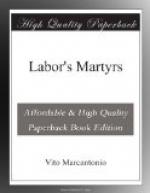The man who spoke these words had no illusions. He knew that the court he was facing was a hostile court, an enemy court, a court determined to stamp out all that he stood for and believed in. He knew, also, that the truth of which he spoke was much bigger than the little man who sat in a black gown waiting for him to finish so that he could pronounce the brutal words that would mean his death on the gallows. He knew that the movement he represented was bigger than the forces which were trying to crush it and that it would survive.
Survive it did—to become one of the most powerful factors on the American scene today, one of the most vital factors in the extension and preservation of democracy and the rights for which he laid down his life.
And why should we venerate the memory of this man and the other victims of the Haymarket tragedy? Not simply because they were brave men. Not simply because they had the courage of their convictions and did not weaken in the face of death. But because their fight is still going on today, strengthened by their magnificent pioneer work, because of the foundation they helped lay for the American labor movement of the present day.
Back in 1886, that movement was still almost in its infancy. Noble attempts to build it had been made in the days of our Revolutionary forefathers. But all they did was to lay the groundwork, to drive in the first piles on which the rest of the structure could be built. The man of the early ’eighties of the last century began the actual construction.
One of the main issues around which they rallied the working people of this country was the fight for the eight-hour day. Albert Parsons, only 36 when he was executed, had spent more than ten years actively organizing American workers. He was a printer, a member of the powerful International Typographical Union which even in those days had over 60,000 members. He was a member of the Knights of Labor, the first great trade union center in American history. He was one of the outstanding spokesmen of the eight-hour day. An able orator, he toured the United States, soap-boxing, lecturing and recruiting supporters for the movement.
By his side was August Spies, a German worker from the metal trades industry, who carried the fight to the Central Trades Body of Chicago to which he was a delegate. Around them were many others: Adolph Fischer, George Engel who came to America as so many of our immigrant forefathers did because he believed “he would live a free man, in a free country.” Oscar Neebe, Samuel Fielden, Michael Schwab and young Louis Lingg, only twenty-three at the time of his death.
Their efforts bore fruit. The movement for the eight-hour day gained momentum. Union after union discussed the problem and went on record in favor of fighting for it, until finally the slogan became: General Strike for the eight-hour day. The date set was May 1, 1886, a day that has now become the international fighting holiday of labor.




